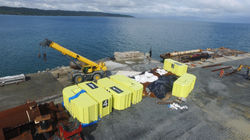

Design
Our buoys are fully designed and modelled in 3D finite Element Analysis software Ansys. This allows us to set load paths and configure fatigue loadings for environmental forces. Steel thicknesses and stiffening locations are adjusted to suit and the final model will meet all standards of the design code and client specification.

Manufacture
From our detailed designs full production drawings are produced and approved by a third party where necessary before fabrication commences. Our workshops, positioned in strategic locations around the world, have the capacity to produce heavy fabrication and fitting out of our products allowing for local delivery on a global scale.

Delivery
After manufacture the finished units are packed in containers or loaded to lorries for delivery through to the clients site. As our market covers the World we have experience in handling a full spectrum of transport requirements, all of which are covered by our stringent Quality Assurance program and executed with the greatest degree of detail and care.

Installation
DockGuard can produce a fully detailed handling, assembly and installation manual providing detailed description on how to install the products. Additionally DockGuard’s experienced engineers will be on hand to provide practical advice and specific instructions for the safe and efficient assembly, installation and commissioning of the products.
SERVICES
A Conventional Mooring Buoy System generally consists of multiple buoys. The exact configuration depends on water depth, field requirements and environmental conditions. Typically it is a pattern of four to eight mooring points used to moor tankers. Each point consists of a rigid buoy moored to the seabed by a chain and an anchor. The prime purpose of each buoy is to act as an anchoring point for the tanker to berth. The buoys are moored to the seabed, therefore, the tanker berths without use of its own anchors.
Each buoy has a chain hawser assembly through the centre of the buoy unit, terminating in a chain stopper on deck. The buoys are normally fitted with double quick release hooks to disconnect quickly from the tanker. Hawsers are connected to the bow or stern of the tanker on one end and to the quick release hook of the buoy on the other end.
After mooring to the buoys, the tanker may start (off) loading by connecting a subsea hose string to the ships manifold. The other end of the hose string connects to the Pipe Line End Manifold (PLEM), fixed to the seabed or any other pipeline transferring the product to or from any installation located onshore or offshore. Should the tanker leave the berth, the hose string will be laid down on the seabed, to be picked up again when the next tanker arrives.
Anchor arrangement - An anchor arrangement is deployed to connect the buoy to the seabed. For each buoy, dynamic behaviour calculations predict the behaviour of the buoy for various wind, wave and current conditions. These calculations determine the optimum anchor leg arrangement, and the size of the various anchor leg components.
Mooring Buoy Systems
Our experienced team can travel to your site and offer a full suite of installtion and comissioning services
Fully intergrated production
Steel Fabrication
Shotbalsting & Painting
Inspections & Certification
Full Design Services
Structural Calculations
F.E. Anaylsis
Fabrication Drawings
 |  |  |
|---|---|---|
 |  |  |
 |  |  |
A selection of images from our most recent design, supply and install contracts
PROVEN IN PRACTICE
ABOUT US
DockGuard is a global provider of bespoke marine equipment. Our main focus is in Fenders and Mooring System. Unlike other companies DockGuard business is founded on the principles of high end value engineering that ensures our clients benefit from our experience in first principle designs. We work according to the latest international design codes and have a dedicated team working towards the most efficient design on each project.
DockGuard employ the most up to date technology to ensure every aspect and detail of the design is thoroughly thought out and optimised for strength and economy. This process ensures our manufacturing costs are kept to a minimum and there is no wasted material resulting in a overpriced end product.
Our skilfully engineered products can be found in Ports and Harbours all over the world. We work closely with our clients' chosen Consultant to ensure the project brief is followed and our high standards in Quality Assurance and Project Management are completed to their satisfaction.
